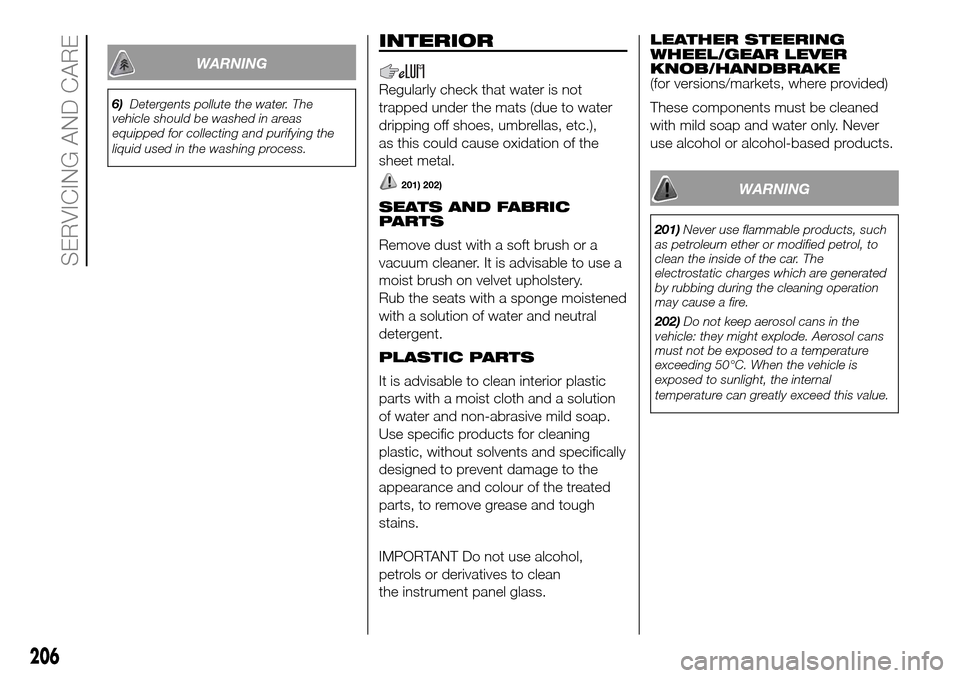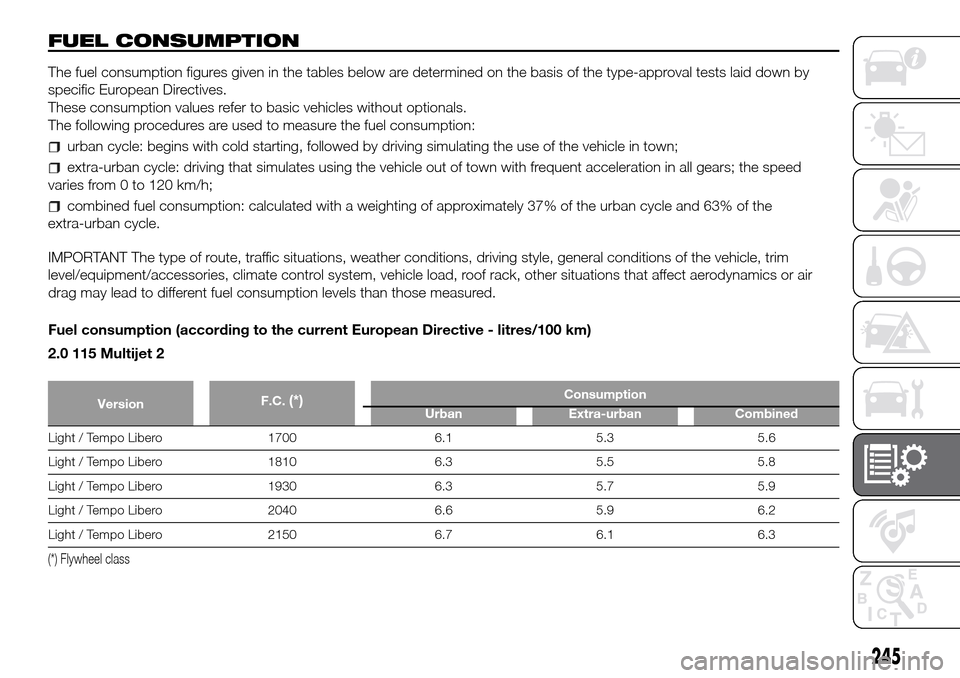Page 202 of 296

USEFUL ADVICE FOR
EXTENDING THE LIFE OF
YOUR BATTERY
To avoid draining your battery and
make it last longer, observe the
following instructions:
when you park the vehicle, ensure
that the doors, tailgate and bonnet are
closed properly, to prevent any roof
lights from remaining on inside the
passenger's compartment;
switch off all roof lights inside the
vehicle: the vehicle is however
equipped with a system which switches
all internal lights off automatically;
do not keep accessories (e.g. radio,
hazard warning lights, etc.) switched
on for a long time when the engine
is not running;
before carrying out any operation on
the electrical system, disconnect the
negative battery cable through the
suitable terminal;
completely tighten the battery
terminals.IMPORTANT After turning the ignition
key to STOP and having closed the
driver side door, wait at least one
minute before disconnecting the
electrical supply from the battery. When
reconnecting the electrical supply to
the battery, make sure that the ignition
key is in the STOP position and the
driver side door is closed.
IMPORTANT If the charge level remains
under 50% for a long time, the battery
is damaged by sulphation, reducing
its capacity and efficiency at start-up.
The battery will also be more at risk
of freezing (this can happen already at
-10°C).
Refer to the paragraph "Car inactivity"
in "Starting and driving" if the car is
left parked for a long time.If, after buying the vehicle, you want to
install electrical accessories which
require permanent electric supply
(alarm, etc.) or accessories that in any
case burden the electrical supply,
contact a Fiat Dealership, whose
qualified personnel, in addition
to suggesting the most suitable devices
from Lineaccessori Fiat, will evaluate
the overall electrical consumption,
checking whether the vehicle’s electrical
system is capable of withstanding the
load required, or whether it should
be integrated with a more powerful
battery.
Since some of these devices continue
to consume electricity even when
the engine is off, they gradually run
down the battery.
IMPORTANT If a tachograph is fitted, if
the vehicle is parked for a long period
of 5 days, it is advisable to disconnect
the negative battery terminal to
maintain its charge.
If the vehicle is equipped with a battery
disconnection function (disconnector),
see the description of the procedure
in the "Controls" paragraph in the
"Dashboard and controls" section.
200
SERVICING AND CARE
Page 204 of 296

NOZZLES
Windscreen (washer) fig. 193
If there is no jet, first check that there is
fluid in the reservoir.
Then check that the nozzle holes are
not clogged; use a needle to unblock
them if necessary.
The washer jets should be positioned
by adjusting the angle of the sprays
using a small straight-headed
screwdriver.
The jets should be directed at about a
third of the height from the top edge
of the windscreen.HEADLIGHT WASHERS
Check the correct condition and
cleanliness of nozzles at regular
intervals.
The headlight washers come on
automatically when the windscreen
washer is operated with the low beams
on.
WARNING
195)Driving with worn windscreen wiper
blades is a serious risk, because visibility is
reduced in bad weather conditions.
WARNING
56)Do not operate the windscreen wiper
with the blades lifted from the windscreen.
LIFTING THE
VEHICLE
If the vehicle needs to be lifted, go to a
Fiat Dealership which is equipped
with the arm hoist or workshop lift.
193F1A0242
202
SERVICING AND CARE
Page 208 of 296

WARNING
6)Detergents pollute the water. The
vehicle should be washed in areas
equipped for collecting and purifying the
liquid used in the washing process.
INTERIOR
Regularly check that water is not
trapped under the mats (due to water
dripping off shoes, umbrellas, etc.),
as this could cause oxidation of the
sheet metal.
201) 202)
SEATS AND FABRIC
PARTS
Remove dust with a soft brush or a
vacuum cleaner. It is advisable to use a
moist brush on velvet upholstery.
Rub the seats with a sponge moistened
with a solution of water and neutral
detergent.
PLASTIC PARTS
It is advisable to clean interior plastic
parts with a moist cloth and a solution
of water and non-abrasive mild soap.
Use specific products for cleaning
plastic, without solvents and specifically
designed to prevent damage to the
appearance and colour of the treated
parts, to remove grease and tough
stains.
IMPORTANT Do not use alcohol,
petrols or derivatives to clean
the instrument panel glass.LEATHER STEERING
WHEEL/GEAR LEVER
KNOB/HANDBRAKE
(for versions/markets, where provided)
These components must be cleaned
with mild soap and water only. Never
use alcohol or alcohol-based products.
WARNING
201)Never use flammable products, such
as petroleum ether or modified petrol, to
clean the inside of the car. The
electrostatic charges which are generated
by rubbing during the cleaning operation
may cause a fire.
202)Do not keep aerosol cans in the
vehicle: they might explode. Aerosol cans
must not be exposed to a temperature
exceeding 50°C. When the vehicle is
exposed to sunlight, the internal
temperature can greatly exceed this value.
206
SERVICING AND CARE
Page 212 of 296
ENGINE MARKING
It is stamped on the cylinder block and
includes the type and the engine serial
number.
CYLINDER MARKING
Each methane cylinder is identified in
the factory with a stamp on the nose of
the cylinder.
The other plates provided by the
Dealership with the vehicle documents
show the date when the first cylinder
inspection/test is due.
59)
SYSTEM INSPECTION
The cylinders must be inspected, in
accordance with ECE Regulation
Procedure no. 110, every 4 years from
the vehicle registration date or in
accordance with specific regulations in
individual countries.
WARNING
59)If the vehicle has been registered in a
country other than Italy, the certification
data, identification and inspection
procedures for the methane cylinders
should conform to the legislation in that
country. In any case, it should be
remembered that the life of the cylinders is
20 years from the production date as set
out in ECE Regulation no. 110.
199F0N0405M
210
TECHNICAL DATA
Page 214 of 296
WHEELBASE
AShort wheelbase
BMedium wheelbase
CLong wheelbase
DMedium-long wheelbase
UAll wheelbases (incomplete vehicles)
BODY
ACab chassis
BChassis without cab
CPlatform chassis cab
DBox truck
EPrimary school bus
FVa n
GLong cab tipper
HLong cab chassis
MMinibus
PPanorama
RCombinato 6/9-seater
212
TECHNICAL DATA
Page 242 of 296

3.0 140 Natural Power Prescribed fuels and original lubricants
Fuel tank (litres):Petrol: 14.5
Methane (kg): 36(§) (°°)Petrol with an octane number (RON) no lower
than 95 (EN228 specification)
Automotive methane and bio-methane
(EN16723 specification)
Including a reserve of (litres): Petrol: 8
Engine cooling system (litres):
10
(***)Mixture of distilled water and PARAFLUUP
liquid at 50%(****)
Transmission/differential casing (litres): 2.9 TUTELA TRANSMISSION GEARTECH
COMFORT-MATIC transmission hydraulic
actuation system (litres):0.7 TUTELA CAR CS SPEED
Clutch hydraulic activation system (litres): 0,050 TUTELA TOP4
Hydraulic braking circuit with ASR/ESC (kg): 0.62TUTELA TOP 4
TUTELA TOP4/S
Hydraulic power steering: 1.5 TUTELA TRANSMISSION GI/E (red)
(§) Range on Methane: 400 km
(°°) The amount of methane depends on the outside temperature, the supply pressure, the quality of the gas and the type of refuelling system. The total volume of
the cylinders is about 220 litres (218.5 nominal) for all versions.
(***) With Webasto: + 1/4 litre - Underseat heating 600cc: + 1 litre - Underseat heating 900cc: + 1.5 litres - Underseat heating + Webasto: + 1.25 litres - Underseat
heating + Webasto: +1.75 litres
(****) When the vehicle is used in particularly harsh weather conditions, we recommend using a 60-40 mixture of PARAFLU
UPand demineralised water.
IMPORTANT Note that when using a fuel like methane, the range is extremely variable because in addition to the vehicle
maintenance and driving conditions it also depends on the temperature of the gas in the cylinder. The methane actually heats
up during the refuelling and cools down whilst driving, undergoing variations in pressure that reduce the quantity that can
be used.
240
TECHNICAL DATA
Page 247 of 296

FUEL CONSUMPTION
The fuel consumption figures given in the tables below are determined on the basis of the type-approval tests laid down by
specific European Directives.
These consumption values refer to basic vehicles without optionals.
The following procedures are used to measure the fuel consumption:
urban cycle: begins with cold starting, followed by driving simulating the use of the vehicle in town;
extra-urban cycle: driving that simulates using the vehicle out of town with frequent acceleration in all gears; the speed
varies from 0 to 120 km/h;
combined fuel consumption: calculated with a weighting of approximately 37% of the urban cycle and 63% of the
extra-urban cycle.
IMPORTANT The type of route, traffic situations, weather conditions, driving style, general conditions of the vehicle, trim
level/equipment/accessories, climate control system, vehicle load, roof rack, other situations that affect aerodynamics or air
drag may lead to different fuel consumption levels than those measured.
Fuel consumption (according to the current European Directive - litres/100 km)
2.0 115 Multijet 2
VersionF.C.(*)Consumption
Urban Extra-urban Combined
Light / Tempo Libero 1700 6.1 5.3 5.6
Light / Tempo Libero 1810 6.3 5.5 5.8
Light / Tempo Libero 1930 6.3 5.7 5.9
Light / Tempo Libero 2040 6.6 5.9 6.2
Light / Tempo Libero 2150 6.7 6.1 6.3
(*) Flywheel class
245
Page 254 of 296
CO2EMISSIONS
The CO2emission figures in the table below refer to combined fuel consumption.
These emission values refer to basic vehicles without optionals.
CO
2emissions (according to the European Directive in force g/100 km)
2.0 115 Multijet 2
Version
F.C.(*)CO2emissions
Combined
Light / Tempo libero 1700 147
Light / Tempo libero 1810 152
Light / Tempo libero 1930 152
Light / Tempo libero 2040 162
Light / Tempo libero 2150 167
(*) Flywheel class
252
TECHNICAL DATA